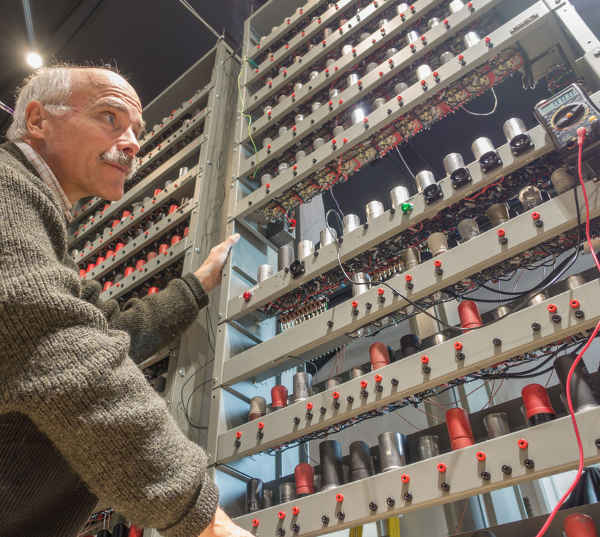| Integrating EDSAC |
| Written by Sue Gee | |||
| Saturday, 12 December 2015 | |||
|
EDSAC, the Electronic Delay Storage Automatic Calculator, was originally built immediately after World War II at the University of Cambridge, England. It is now being re-built at the UK's National Museum of Computing, with components being worked on by volunteers with skills and knowledge from their careers in the UK's computer industry.
As project manager Andrew Herbert explains in the latest progress report video while the EDSAC looks deceptively complete in its gallery at TNMOC there is still a lot of work to be done to integrate all its various components and achieve the goal of a functioning replica.
One of the twenty-strong team of volunteers Chris Burton says: "We've got to the point in commissioning the EDSAC that we're on the brink, within a few months, of having some interesting things to see - such as individual instructions being executed, some numbers counting, perhaps, some real data in the memory as distinct from simulated data, because there's sufficient of the machine, although its not complete yet, to start integrating various components, various units together." In the next phase of the project one of the challenges will be to get the control and arithmetic units to work together. Working in Cambridge, Nigel Bennee has nearly finished his work on the arithmetic unit, which will shortly be shipped to TNMOC. Meanwhile James Barr is working on the order coding system and master control unit, consisting of 12 chassis and 3 chassis respectively. Explaining the use of strange terminology in the video, Barr says: We are trying to stick to the traditional language that was in use at the time. Wilkes referred to them as "orders", the modern terminology is instructions. The order coding chassis deal with the fact that in the memory of the computer instructions are coded as a number consisting of 5-bits.
The work Barr is doing requires a knowledge of thermionic valves or tubes that were used for war-time RADAR and preceded the invention of transistors and silicon chips. They were the only devices at that time fast enough for a high-speed computing technology. He also has had to research and re-discover the ways that 1940’s valve circuits were made to perform digital functions. However the fact that he was himself a Cambridge University undergraduate, albeit more than two decades after the original EDSAC was built there, means he is ideally suited to be a volunteer on the reconstruction project. In the early 70s when he went up to Downing College, Cambridge University, Computer Science was a fledgling science. However, after first studying ‘proper’ science for two years Barr was permitted to take computer science as a subject in its own right. He recalls: “That computer science course was run by none other than Sir Maurice Wilkes, computer pioneer and designer of EDSAC. The other course lecturers were a remarkable team of famous computer pioneers. I still have my detailed notes and coursework that are proving to be a rare archive, giving insights into the development of early computing and its education.” After Cambridge, Barr went on to work in the computer industry as a programmer and then project manager and analyst until his retirement in 2012. It was only than that he heard of the reconstruction of EDSAC and felt he might have something to contribute and came to making over his garden shed into Edshack, one of several home workshops across England that are being transported back in time as they play their part in the reconstruction.
Andrew Herbert commented: "Reconstructing a computer using technologies that are 65 years old might seem impossible, but we are fortunate in having a window of time in which to utilise the skills of people like James who have an understanding of a range of technologies from thermionic valves through transistors to silicon chips. Of course, we need to be careful not to get ahead of ourselves and to be faithful to the technologies that actually existed in the late 1940s and early 1950s, so that the EDSAC we recreate is as close as we can possibly get to the original machine.” More InformationRelated ArticlesEDSAC Display Officially Opened EDSAC Reconstruction Demoed To Celebrate Wilkes Centenary On this day in 1949 - EDSAC performs stored-program calculation
To be informed about new articles on I Programmer, install the I Programmer Toolbar, subscribe to the RSS feed, follow us on, Twitter, Facebook, Google+ or Linkedin, or sign up for our weekly newsletter.
Comments
or email your comment to: comments@i-programmer.info |
|||
| Last Updated ( Friday, 11 December 2015 ) |




